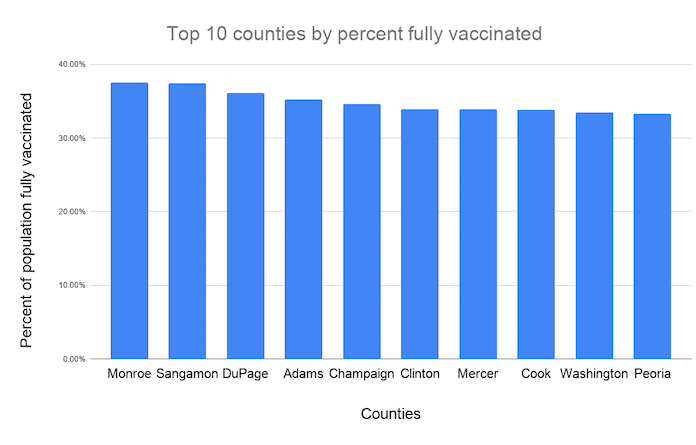IDPH adds COVID death; low turnout for vaccine clinic

The Illinois Department of Public Health added another death Friday to Monroe County’s death toll from the novel coronavirus, putting the total at 93. The deceased was a man in his 70s.
The IDPH also reported deaths last Wednesday and this Wednesday.
Amid these deaths being added, Monroe County’s vaccine clinic on Thursday went “not very well,” according to Monroe County Health Department Administrator John Wagner.
The county administered around only 200 doses at the Thursday evening clinic at the fairgrounds, including some second doses and about 50 Johnson & Johnson shots.
“It was not a good turnout,” Wagner said. “It was just a trickle in.”
Depending on how Monday’s clinic goes, it may be the last of its kind in Monroe County for first doses, Wagner said.
This comes after Gov. JB Pritzker announced Thursday that Illinois will move to the new Bridge Phase of its reopening plan next week. Barring any setbacks, Pritzker said the state is then on track to fully reopen as early as June 11 when it reaches Phase 5 of the Restore Illinois plan.
“The concerning upward movement of cases and hospitalizations we were seeing a few weeks ago have stabilized – a testament to the lifesaving, community-protecting power of vaccinations,” Pritzker said. “As a result, on Friday, May 14, the State of Illinois will move into the Bridge Phase of our mitigation plan – one step closer to removing nearly all of the remaining mitigations, and a very hopeful move toward fully reopening. I want to thank people across Illinois who are getting vaccinated, wearing their masks and continuing to do their part to make your friends and family safer and your communities healthier.”
The Bridge Phase allows for higher capacity limits at spectator events and has fewer limitations on businesses.
To advance to this phase, the entire state must reach a 70 percent first-dose vaccination rate for residents ages 65 and over, maintain a 20 percent or lower ICU bed availability rate and hold steady on COVID-19 and COVID-like illness hospital admissions, mortality rate and case rate metrics over a 28-day monitoring period.
Pritzker said 85 percent of Illinoisans ages 65 and older have received their first dose, while 60 percent of all adult residents have gotten their first shot.
Illinois overall has administered 10,037,624 doses of the vaccine and received over 12.5 million doses. A total of 4,552,454 residents have gotten both shots, which means 35.73 percent of Illinois is fully vaccinated.
To move to Phase 5, which is when life returns to pre-pandemic normal, the state must reach a 50 percent vaccination rate for residents ages 16 and over and meet the same metrics and rates required to enter the transition phase, over an additional 28-day period.
In addition, Pritzker announced that state-managed mass vaccination sites will now offer walk-in appointments and that doctor’s offices and small medical providers will begin offering the vaccine.
After widespread complaints that Monroe County was not receiving its fair share of the COVID-19 vaccine earlier this year, the county has emerged as a standout in vaccinations as it is now among the top counties in the state in terms of percentage of residents inoculated.
According to Illinois Department of Public Health data from May 2, Monroe County led the state with 37.55 percent of its population being fully vaccinated.
“It’s really good,” Monroe County Health Department Administrator John Wagner said of that statistic. “It says a lot about our mass clinic’s availability and people taking advantage of getting vaccinated. It’s one of the reasons that we’re running out of people to vaccinate.”
Based on Republic-Times calculations using IDPH data, Monroe County also ranked third in the state in terms of percent of population that has received at least one shot and eighth in percent of population that has received only one shot. Those figures were at 78.25 percent and 40.69 percent, respectively, at the start of this week.
Wagner said his efforts to secure more doses of the vaccine shortly after it became available, the relatively large population of older individuals in the county, and the high average education level all probably contributed to those numbers.
Older people and those with higher education are typically more likely to get vaccinated.
Those numbers, however, may not be totally accurate.
For example, they do not include county residents who may have gotten inoculated elsewhere, and they may include people who only work here but got the shot here or those who came from other areas of the state to get vaccinated.
While that most likely would cause those percentages to fluctuate some, Wagner did not estimate the changes would be too significant.
Although Monroe County has excelled so far, Wagner said it appears the demand for the vaccine is slowing down drastically.
He predicted his office would only fully vaccinate about 45 percent of the county’s population before stopping its mass clinics due to lack of people getting the vaccine.
“There’s nothing more we’re going to do,” Wagner said. “If the vaccine’s out there and anybody who’s had a chance to get it that’s wanted it, nothing new’s going to come down the pike.”
The problem with such a low vaccination figure is that the virus can continue to spread among unvaccinated individuals, allowing it to mutate and potentially becoming more serious or resistant to the vaccines.
For Monroe County, Wagner said the problem could especially be in the youngest age groups eligible for the shot.
“The younger group, I would like to see that number a little higher than what we have, and I understand why it’s not,” he said. “If it stays the way it is, it’s going to make school difficult come next year. We’ll figure out how to do it, but the easiest thing would be if everybody gets vaccinated.”
Those as young as 16 are currently eligible for at least one vaccine, and Pfizer-BioNTech is working to make its shot eligible for those as young as 12.
The problem, Wagner said, is that large portions of the school will have to be quarantined due to exposure to positive cases if many students remain unvaccinated.
Once the vaccines are approved for younger students, which appears likely, Wagner said schools may require students to get the COVID vaccine to attend – much the way they do with other vaccines now.
“I could see schools going to that,’” Wagner said. “I’m not too sure how we’re going to do it if we don’t do that.”
Even with these problems, Wagner argued the state should soon return to pre-pandemic normal in many regards since the vaccine is so widely available.
“We’re getting to the point where we should be opened back up,” he said. “Everybody who wants to get vaccinated has had a chance to get vaccinated. Now we need to draw back and just start watching the hospitals. Make sure we don’t run into a problem with hospital capacity.”
If hospitals begin to be overwhelmed by coronavirus patients, Wagner said measures to curb the spread will again be necessary.
He also hoped such a scenario would convince those hesitant to get the vaccine, as he thinks some of the hesitancy now is due to the pandemic being at a low point.
Clinic on Monday
With this in mind, Monroe County is planning to host what may be its final mass vaccination clinic in the next week.
The Moderna and Pfizer-BioNTech vaccines will be offered at a clinic this coming Monday from 11 a.m. to 3 p.m. at the fairgrounds. Some of those are for second doses, but there will be some for first doses.
“We’re going to gauge the desire to see if we can keep them mass clinics going or if we have to draw them back,” Wagner said. “There’s just not a lot of demand out there.”
“We have enough doses, but we may not have enough people to give them to,” Wagner added.
If the county has a large number of leftover doses, Wagner said he will need to scramble to send them somewhere else – which may be difficult because many other counties are seeing the same drop in demand.
A recent illustration of that decline came last week when the health department held a 60-dose clinic at Bolm-Schuhkraft Park in Columbia in an effort to use some remaining doses and determine whether Columbia residents had been reluctant to drive to Waterloo to get vaccinated.
Wagner said that clinic went “absolutely horrible” because only four people came to get their shots.
Monroe County will not offer any doses of the Johnson & Johnson vaccine because its supply expired while that vaccine was paused due to safety concerns that have now been addressed.
The Illinois Department of Public Health reports Monroe County has administered 27,902 doses of COVID vaccines. There are 13,699 people fully vaccinated here – meaning 39.9 percent of the county has received both shots.
In addition to the county health department, individuals can now also get vaccinated at Mercy Hospital by visiting mercy.net/MOVaccineInfo or by scheduling an appointment at the Waterloo Walmart at walmart.com/COVIDvaccine.
Those places join Red Bud Regional Hospital, Memorial Hospital in Belleville and the Columbia and Waterloo Walgreens as other nearby locations residents can get shots.
Monroe County has had a total of 4,387 cases of COVID-19 since the pandemic began, about 31 of which are active. One resident is hospitalized with the virus for the first time in many months. There have been 24 new cases since April 28.
Overall, the Waterloo zip code has had 2,227 cases (27,767 tests performed), the Columbia zip code has had 1,670 cases (12,134 tests) and the Valmeyer zip code has had 168 cases (1,101 tests), according to the IDPH.
Monroe County’s seven-day rolling average test positivity rate was 1.5 percent on May 8. The seven-day rolling average positivity rate for the metro east was 2.7 percent on May 8. The region has 34 percent of its ICU staffed beds available.
In St. Clair County, there have been 30,740 total positive tests and 477 coronavirus-related deaths. A total of 349,644 tests have been performed there.
Randolph County has had 4,151 confirmed cases, nine of which are active. Eighty-five people have died from the virus there.
Illinois overall is up to 1,357,953 cases of coronavirus and 22,261 deaths. There are 1,906 people hospitalized with COVID-19 in Illinois, including 489 people in ICU beds.
Missouri has recorded 505,928 confirmed cases and 8,835 deaths. That includes 80,946 cases in St. Louis County and 21,250 cases in St. Louis City, according to the Missouri Department of Health & Senior Services.
Nationally, more than 32.7 million people have contracted the virus, while at least 581,669 people have died.
Worldwide, there have been over 158.9 million cases of coronavirus and over 3.3 million COVID-19-related deaths.






